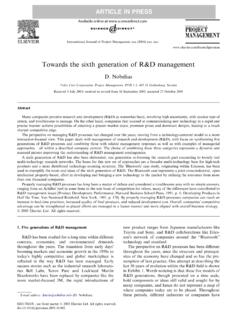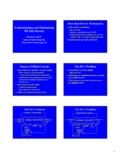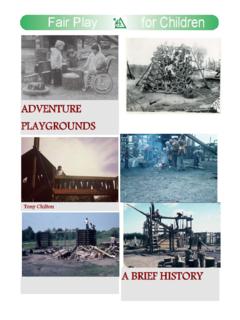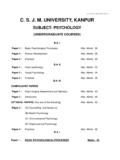Transcription of EXECUTIVE SUMMARY Work Design - Modern Times …
1 1 THE PROCESS & CONTENTOFJOB & work ORGANIATION(RE)DESIGNEXECUTIVE SUMMARYWork DesignOne of the very quickest ways to increase dignity and meaning in a workplace is to involvepeople in designing their own work . This involvement of front-line staff is also one of themost effective means to identify problems and solutions, leading to lower costs and higherquality service. work Design is, therefore, the involvement of people in developingelements of their work systems to achieve the dual objectives of more productive and moresatisfying work .
2 Ideally, there is feedback on these outcomes for continuous SYSTEMEMPLOYEESEFFICIENCY,EFFECTIVENESSS ATISFACTION,ACCOMPLISHMENTFig. 1: work Redesign In concept, work Design addresses both technical and social aspects of work . "Technical"refers to the Processes (sets of tasks) that must be performed and the means (Technology,procedures and tools). "Social" refers to People (skills and attitudes), and the Structureswhich define their roles and Both aspects are deemed vital toperformance, and as interdependent elements of a system , improving their overall "fit" isconsidered more critical than optimizing one or the other.
3 PROCESSES (Sets of Tasks) STRUCTURES (Jobs & Organization) TECHNOLOGY(Procedures, Tools) PEOPLE (Skills, Attitudes)Fig. 2: Elements of a work System 1 Kolodny, H. et al, Job Design and Sociotechnical Systems, Labour Canada, Process of Workplace ChangeIn terms of methodology, the basic premise is self- Design . Alternative designs of workshould be developed by those workers and managers who are members of the unitcontemplating change. Indeed, most work Design is (re) Design .
4 That means significantchange -- in established work practices, work roles, etc. So important is the change factor,that work redesign should start with attention to the process of involves a crucial Transition State between the Present State and a proposed NewState. Transition is the 'black-hole' into which many proposed changes sink before everreaching implementation in a New State (see Figure 3). *familiar *unknown*controllable *riskyFig. 3: Three States of Change * letting go of old work * taking on of new work * ambiguity, uncertainty* coping with loss and/or gainTo manage this often chaotic Transition requires a series of steps--a process (see Figure 4:Change Process Model).
5 There are four main stages to the process which is not linear, andmay require looping back to reinforce commitment, or leaping foward to exploreopportunities. However, each step is StartedThe primary requirement is for all key stakeholders to be involved in determining orrecognizing the need for change. There must be a critical mass of information that justifiesbreaking from the status quo, either because of existing problems or anticipatedopportunities. Often, awareness has to be heightened and new information has to beshared.
6 Even still, acceptance of the need to change requires that people perceive thepossibility of remedy. Generally, the exploration of options draws upon other worksites'experience of innovation through case-studies, site visits, bench-marking, seminars, , the organizational situation has to be assessed (and perhaps, upgraded) in termsof available resources, necessary information, and a better appreciation of what's in it forkey stakeholders. This will determine the scope, timing, and viability of an initiative.
7 Oneprior condition to the viability of work redesign is the existence of a valid and clearmission or "business" strategy for the organization, (ie. form follows function).* familiar * unknown* controllable * letting go of old work * risky taking on of new work ambiguity, uncertainty coping with loss3* Understand & Accept The Need or Opportunity- Involve Key Stakeholders- Explore Options* Assess the Situation- Resources, Relationship* Design the Desired Future- Form Design Structure & Strategy- Develop a Vision- Analyze "Socio-Technical" Needs- Evaluate Alternative Solutions* Assess the Impact of Change- Get Endorsement * Organize a Transition Plan * Evaluate the Process* Monitor & Fine-Tune- Assess Needs forFuture Change Fig.
8 4: Change Process ModelSources: Adapted from Managing Complex Change Workbook, Being First Inc., 1989; and, The Organization Change Process, Ontario Task Force on the Organization of work , 1994.* Implement the Changes* Formalize the New StatePLANNING THE CHANGESGETTING STARTEDMAKING THE CHANGESSUSTAINING CHANGEL abour-Management ParticipationParticipation occurs throughout the process, and especially while "getting started" when thekey stakeholders must develop their commitment to each other as well as to the parties must come to understand each other's objectives for change, and respect howtheir objectives may differ.
9 Too often, management or, to a lesser extent, labour hasattempted to sell its well-researched recipe for change, which the other party has invariablyrejected as a "cooked meal".Fig. 5: Labour-Management Participation ModelPotential ConflictCOMMON GROUND - Potential to Increase4 The arena for meaningful participation (ie. joint ventures, partnership, strategic alliance) isthe common ground where the interests of labour and management overlap (see Fig. 5:Labour-Management Participation Model). It should also be understood that the partiesmay agree to proceed with a particular change, while agreeing to disagree on other the ChangesThe process at this stage consists of four main activities:(1) establishing the structure to steer and manage the redesign process;(2) data collection, through a system scan and sociotechnical analysis;(3) forumulation of redesign proposal.
10 And,(4) development of a transition to Support redesignProper sanctioning and support for work redesign is This is provided by localand/or corporate Steering Groups formed of senior management and union Steering Group acts as an "umbrella" structure, defining objectives and scope forredesign, clarification of issues that are off-limits, and principles which redesign is meantto embody. It also affords protection from interference by wider organizational 6: Structure for work RedesignSteering CommitteeSteering Committee* defines mandate* develops principles* provides support* oversees processRedesignTeamRedesign Team* develops process plan* coordinates or does work analysis, Design * gets stakeholder endorsement* plans for implementationStudy Team(s)(OR) Participative Workshop/Conference SeriesVisionTechnicalDesignExecutive Committee EXECUTIVE Director(s)* reviews redesign proposal for approval 2 McGee, E.










